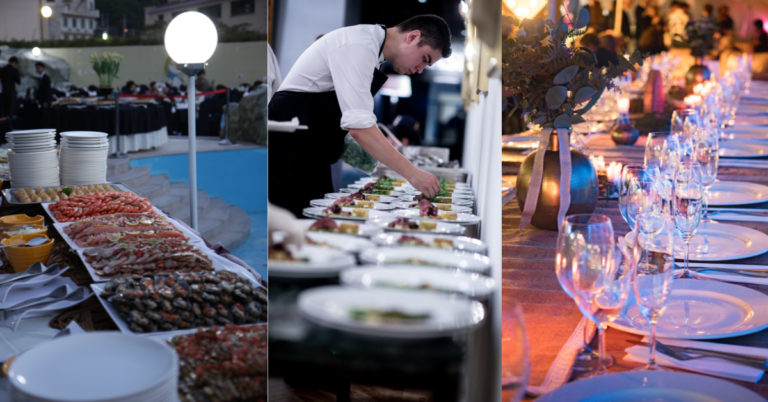How to Care for Chef Knives (Pro Cleaning & Storage Tips)
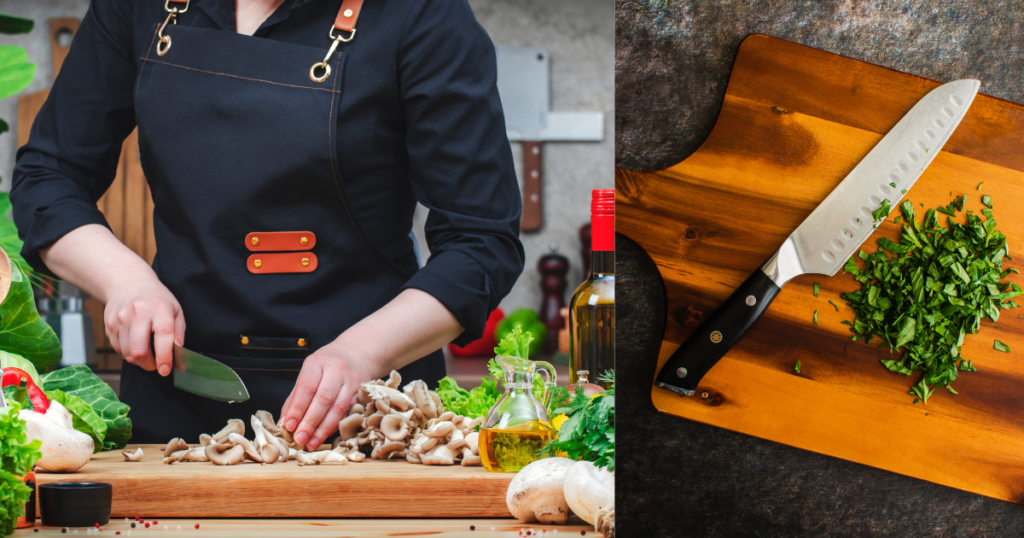
You bought a beautiful chef knife…sharp, balanced, and satisfying to use. But after a few months, it doesn’t slice the same. Sound familiar? Learning how to care for chef knives makes the difference between a blade that lasts decades and one that dulls in months.
With the right cleaning, honing, and storage habits, your knife can stay razor-sharp and safe to use every day.
In this guide, you’ll learn simple knife maintenance routines that keep your investment performing like new.
Why Knife Care Matters More Than You Think
Most people treat their knives like any other utensil …rinse, dry (if that), and toss in a drawer. But here’s the truth: your neglect kills performance, ruins expensive steel, and slowly turns your once-beautiful blade into scrap metal.
Longevity: A Few Seconds of Care = Years of Use
A Miyabi or Wüsthof knife is meant to age with you. But that only happens if you protect it. Leaving a wet knife on the counter, tossing it in the sink, or cutting on glass all chip away at its lifespan. A quick rinse, dry, and safe storage after each use can literally double the lifespan.
Safety: Dull Blades Make You Work Harder (and Riskier)
When a knife loses its edge, you start pressing harder. That’s when slips happen. Keeping your knife sharp means smoother, controlled cuts — and far fewer bandaged fingers. The sharper the blade, the safer your prep.
Performance: A Sharp Knife Changes How You Cook
A dull blade crushes herbs instead of slicing them. It tears tomatoes instead of gliding through. Suddenly, cooking feels like a chore instead of a rhythm. When your knife is sharp and clean, prep becomes faster, cleaner, and even relaxing.
The thing is that if you care for your knife, you respect your craft.
Knife Maintenance: Daily Cleaning & Drying Routine
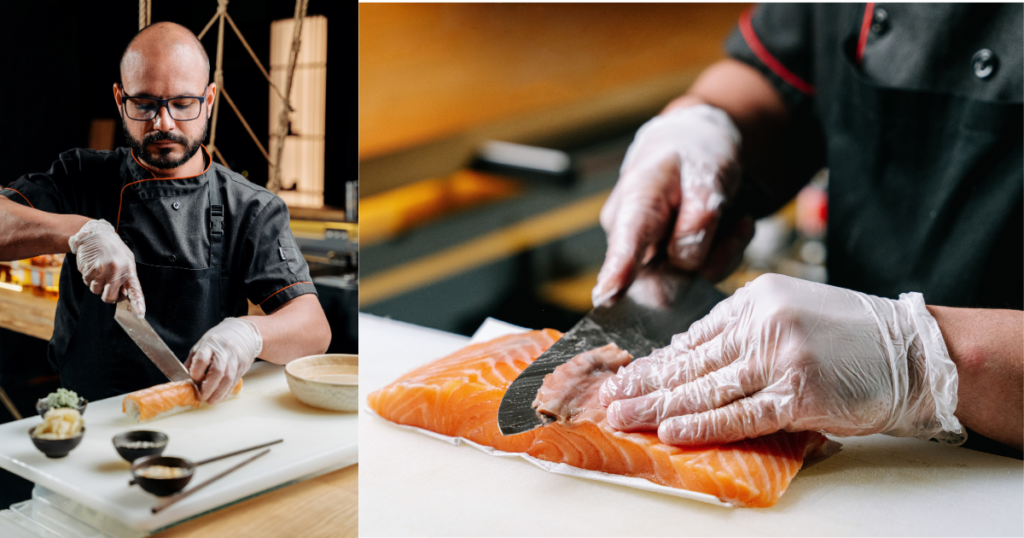
Knife care starts the moment you set it down after slicing. A few mindful steps after each use can save you from dull blades, water spots, and early rust. Here’s how to build a quick but effective cleaning habit that protects your investment.
Hand Wash Only (Never Use the Dishwasher)
Dishwashers are brutal on knives. The high heat, harsh detergent, and rattling against other utensils destroy edges and warp handles. Even premium knives, such as Shun and Miyabi, lose their factory edge after a few cycles.
- Always wash by hand under running water.
- Avoid soaking — water seeps into the handle, causing swelling or corrosion.
- Hold the knife by the spine, not the edge, to stay safe.
Mild Soap & Warm Water Work Best
Skip the scouring pads and harsh cleaners. They strip away the knife’s protective finish and can scratch the steel.
- Use a soft sponge or cloth with warm, soapy water.
- Clean both sides of the blade from the spine to the edge, not from side to side.
- Rinse thoroughly to remove all soap residue… it can stain the steel if left behind.
Dry Immediately (Don’t Let Water Sit)
Water is the silent killer of fine steel. Even stainless blades will spot or rust if left damp.
- Wipe dry with a clean towel right after washing.
- For high-carbon knives like Miyabi or Shun, finish with a few drops of knife maintenance oil to protect against humidity.
Bonus Tip: Use a soft microfiber cloth for daily drying. It’s gentle on polished finishes and keeps your blades looking new.
A clean, dry knife isn’t just about hygiene. It’s the first rule of keeping your blade razor-sharp and ready for years.
How to Keep Chef Knives Sharp
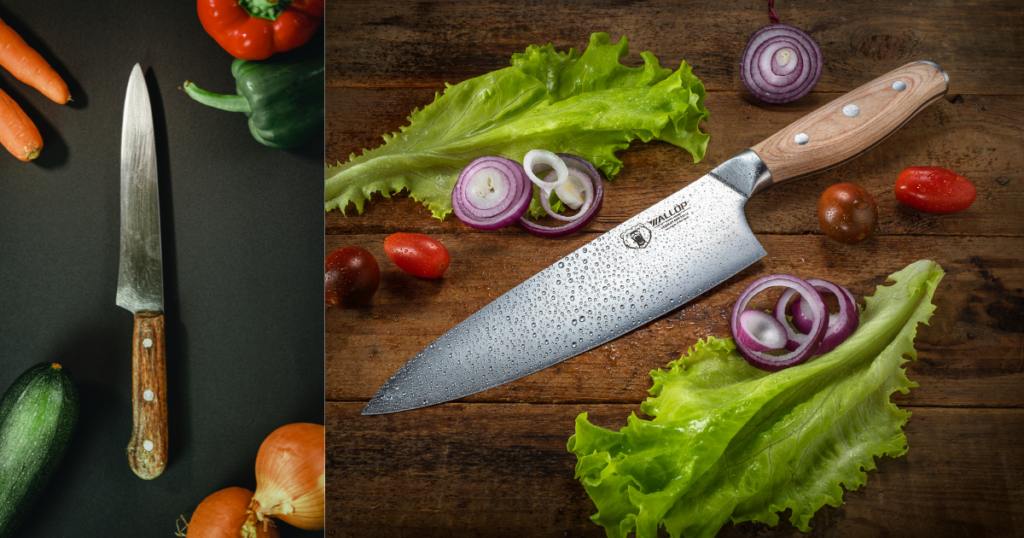
Even the best knife loses its bite with time. That’s normal… steel bends, edges roll, and daily use takes its toll. The trick isn’t avoiding dullness; it’s knowing how to bring the edge back. With regular honing and occasional sharpening, even a Miyabi or Wüsthof can feel brand new for years.
Honing vs. Sharpening: What’s the Difference?
These two aren’t interchangeable.
- Honing realigns the edge that bends slightly after cutting.
- Sharpening removes a thin layer of metal to rebuild the edge.
When to do each:
- Hone every few uses.
- Sharpen only when honing no longer restores the edge.
You’ll know it’s time to sharpen when the knife slips on tomato skin or crushes herbs instead of slicing them.
How to Hone a Knife (Step-by-Step)
You’ll need a honing rod and a steady hand.
- Hold the rod vertically with its tip resting on a towel or a flat surface, such as a board.
- Place the knife at a 15–20° angle — Japanese knives like Miyabi work best at 15°, German knives like Wüsthof around 20°.
- Sweep the blade from heel to tip, alternating between the two sides.
- Repeat 5–6 times per side.
- Wipe the blade clean before storing.
A one-minute routine before cooking keeps your knife aligned and safer to use.
How Often to Sharpen Knives
- Home cooks: every 3–6 months
- Professional chefs: every 2–4 weeks
If you’re cooking daily, schedule sharpening like you would car maintenance — before performance drops.
Best Way to Sharpen Knives
The whetstone is still the gold standard. It gives you full control without overheating or wearing the blade.
For the best results:
- Use a knife care kit between sessions.
- Get professional sharpening once or twice a year.
A well-sharpened knife cuts cleaner, saves prep time, and makes cooking feel effortless — just like the day you bought it.
Smart Storage for Long-Lasting Knife Edges
How you store your knives matters as much as how you use them. Even the best edge dulls fast when it bangs against other tools. Proper storage keeps your knives sharper, safer, and free from rust or chips.
Knife Blocks & Magnetic Strips: Keep Blades Protected
A knife block or magnetic strip keeps each blade separated and easy to reach.
- Use wood or bamboo blocks to cushion the edge.
- When using magnetic strips, make sure the magnet is strong enough to hold knives securely but gentle on the steel.
- Always place the knife side-first on the strip, not edge-first, to avoid micro-chipping.
These options save counter space and prevent blades from rubbing against each other.
Blade Guards or Sheaths: Ideal for Drawers and Travel
If you store knives in drawers or need to transport them, blade guards or plastic sheaths are essential. They protect both the knife and your hands, keeping edges safe during storage or travel. Cloth rolls lined with felt are another option for extra cushioning and portability.
Avoid Loose Drawers: Hidden Damage Adds Up
Tossing knives in a drawer dulls and scratches the edge…and risks cutting your hand. The constant contact wears down even premium brands like Miyabi or Shun.
Best Practice Tip: Store Knives Clean, Dry, and Oiled
Before storing for the long term, wipe the blades with a few drops of knife maintenance oil. This prevents oxidation and keeps steel polished.
Seasonal Deep Knife Maintenance Routine

Even the best knives need a deeper check-up every few months. A seasonal maintenance routine ensures your blades stay sharp, safe, and comfortable for years. Skipping this step gradually reduces performance and lifespan, even for premium brands like Shun or Wüsthof.
Inspect the Edge for Chips or Dull Spots
Inspect the blade closely for small chips, nicks, or uneven edges. Minor imperfections can be corrected with light sharpening or honing. Addressing issues early prevents bigger problems later.
Oil the Blade and Handle
Apply a thin layer of knife maintenance oil, especially on high-carbon steel blades. Wooden handles benefit from light oiling to prevent drying, cracking, or warping.
Tighten Rivets or Screws
Check handles for loose rivets, screws, or fittings. A secure handle improves balance, safety, and control.
Check Balance and Comfort
Hold the knife as you would for prep work. Ensure it feels stable and balanced. If the knife feels off, it may need professional adjustment or handle maintenance.
A simple seasonal check, like inspecting edges, oiling, and tightening, keeps your chef knives performing like new. With consistent care, brands like Wüsthof and Shun knives deliver decades of reliable performance.
Common Knife Care Mistakes to Avoid for Better Knife Maintenance
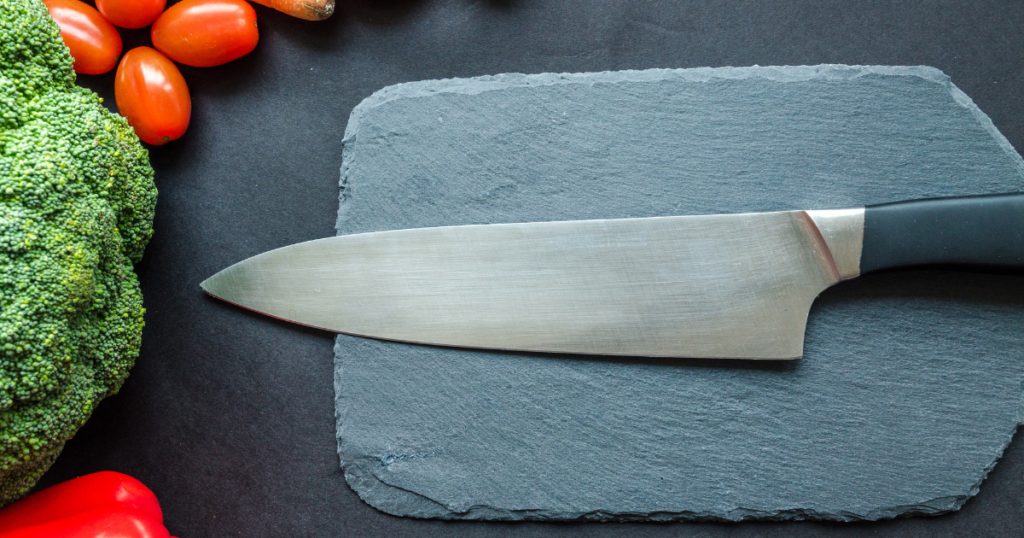
Even experienced cooks make mistakes that shorten a knife’s life. Avoid these habits to keep your blades sharp, safe, and long-lasting.
- Using Glass or Marble Cutting Boards
Hard surfaces quickly dull edges and can chip high-quality blades. Stick to wood or plastic boards.
- Letting Knives Soak in the Sink
Prolonged exposure to water causes rust and damage to the handle. Wash and dry immediately after use.
- Sharpening Too Aggressively
Removing too much metal weakens the blade and shortens its lifespan. Follow proper sharpening angles.
- Ignoring Rust Spots
Small rust spots develop over time, gradually weakening the steel. Address them promptly with gentle cleaning or oil.
- Storing Knives Loosely with Other Utensils
Contact with other items can dull edges and pose a risk of injury. Use blocks, magnetic strips, or sheaths for safe storage.
Final Take: Master Knife Care, Master Your Kitchen
A sharp knife is only as sharp as your maintenance habits. Daily cleaning, periodic honing, and safe storage let your Miyabi, Shun, or Wüsthof knives perform at their best. Invest a little effort now to make every slice effortless.


